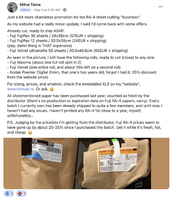CAII in the boxes we all buy is the new generation "digital" paper?
Yes.
To clarify a few things from my end:
"CAii" or "CAII" as such does not exist as a product identifier at Fuji. If you Google this, you'll only find posts of Drew Wiley on LFPF and Photrio using that identifier. It's not a FUJIFILM product name. When I speak of 'plain' Crystal Archive, I'm referring to "FUJIFILM Crystal Archive Paper" - note the lack of further specifiers etc.
Where the "II" version has come from that somehow keeps floating around the net, I don't know. I have always
assumed there was a distinct generation change within the entry-level Crystal Archive paper. For instance, I still have some very old (10+ years?) paper labeled "Crystal Archive" that's coated on a heavier paper base than today's paper, it has a matte finish nearly as matte as today's Velvet, it's free of any mottling, it offers a higher dmax (blacker blacks) than today's papers sold under the same name and it also takes far longer before it expires (e.g. whites becoming yellow). This paper must be from before a couple of changes were made.
However, I now understand, based on what the Fuji people told me, that the changes to their papers don't necessarily come as big generation changes. They change things quite regularly, and there's nothing in the official product nomenclature to reflect those changes. Some changes are relatively minor and will never be noticeable to any of us. Some changes are more apparent, such as the change from the internally produced paper base to the currently used Schoeller paper base. So there really is no "CAII". There is a "DPII" paper, but it's unclear if that somehow relates to an earlier "DP" paper and if so, if it's just a marketing choice (a paper aimed at the same segment, but technologically different) or a technology-oriented choice (actually sharing essential traits with a previous version). I suspect the former, since DPII is technically not all that different from e.g. Maxima, save for thinner emulsion layers.
You can find a (mostly) accurate list of currently manufactured papers by FUJIFILM The Netherlands on this page:
https://www.originalphotopaper.com/en/products/photographic-papers/
It excludes FujiFlex and FujiTrans because they're manufactured in Japan.
As to the 'digital' aspect: all papers manufactured today at least by FUJIFILM in The Netherlands are "for digital". The emulsions coated onto the papers are technically similar and the variation in papers is mostly in (1) paper base, (2) emulsion layer thickness (image-forming, inter-layer and top coat) and (3) surface finish. To the best of my knowledge, no papers are produced anymore by FUJIFILM in The Netherlands that are still compatible with optical printing.
Some of the paper datasheets still mention optical enlargement compatibility. Why this is the case and how accurate it is, I have yet to find out. My suspicion is that they still mention an optical compatibility because you sure can get an image when printing this paper under an enlarger. For instance, reciprocity failure doesn't set in until around 10 seconds (according to the Fuji engineers I spoke to; it was a rough estimate since this parameter isn't very relevant for their main markets, which all expose digitally which means microseconds per pixel) and that technically makes the paper 'compatible' with optical enlargement, which typically takes between a couple of hundred milliseconds and several seconds. Another possible reason why they mention 'optical enlargement' as a possibility is that they define it slightly differently than we do, and refer to digital enlargers such as the De Vere 504DS. While these machines form the image digitally, they otherwise function as any old enlarger. It's possible Fuji refer to this (tiny) niche. A final possibility is that the 'optical' reference is simply not accurate, but has remained in current datasheets due to carryover from old versions - it might simply have been missed by the technical writers who write these documents and overlooked by any reviewers.
In any case, I have been very sure to verify with the people at the Fuji plant that their papers are indeed 'digital only', and the answer is very firmly "yes". Optical enlargement in the sense of projecting a film image onto the paper is an application that they have stopped optimizing products for years ago because the market they supply is predominantly using digital exposure. There are no major labs using optical enlargement, at least no labs that these Fuji people are aware of and are in contact with. It's very well possible that especially in recent years, some minor operations have started dusting off old equipment from the late 1990s to optically enlarge color prints. For instance, Blue Moon Camera in Portland, OR came up earlier this week in another thread and I verified that they indeed use two optical minilabs to make prints. However, the total volume of such operations is so infinitesimally small in terms of total paper volumes compared to the users Fujifilm sell most of their paper to, that they don't even appear as a blip on the radar, let alone that old products are being kept alive and being manufactured to serve that market. It would be nice if Fuji somehow decided to sell a dedicated "optical enlargement paper", but don't hold your breath. They're pretty happy if they can stay afloat doing what they're doing now, let alone adding more (costly) products to their lineup and investing in the R&D and production engineering to do so.
No harm done it if happens; it makes it very visible what's actually happening, so it's even useful in a way.



